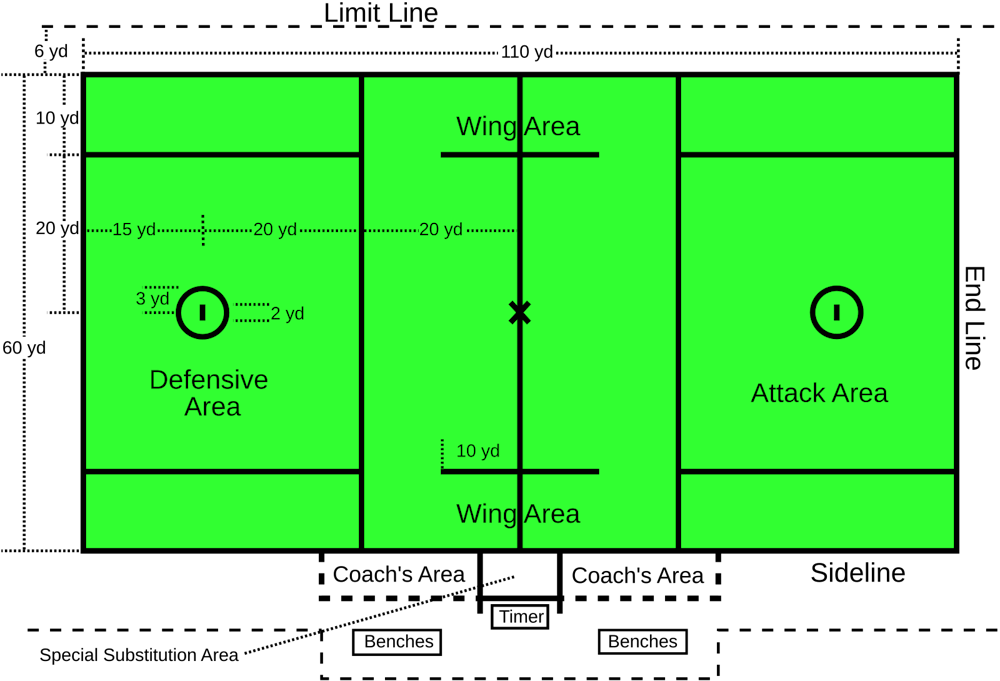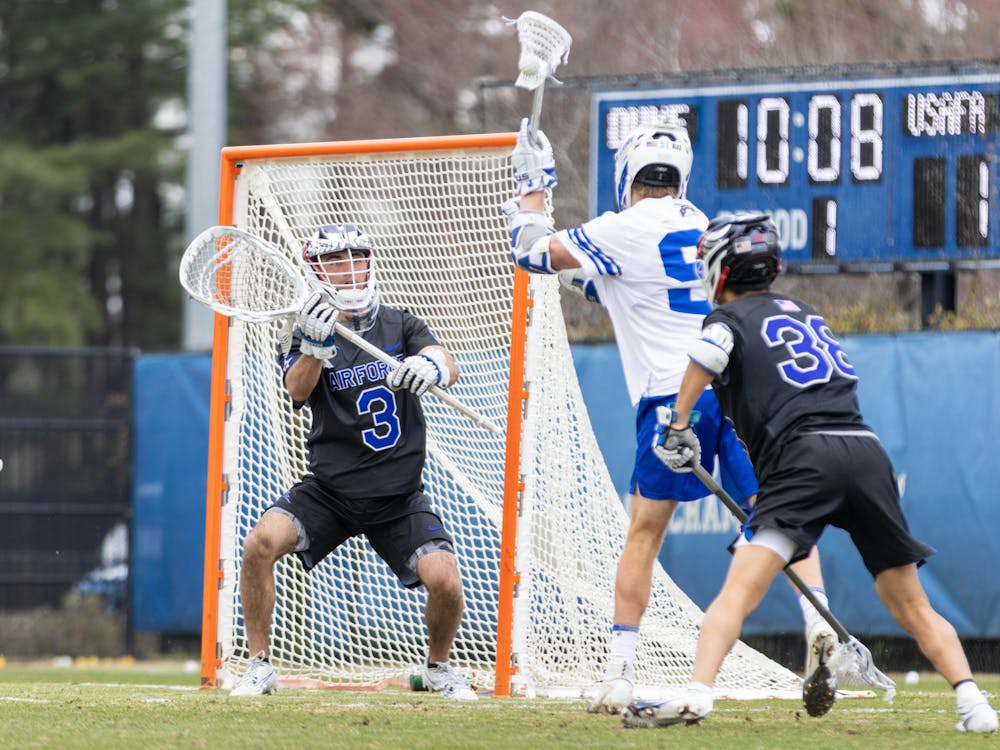As spring sports are underway, The Chronicle is back with our breakdown of every sport, including key rules, terminology, tournament formats and more. Click here to access our beginner's guide to all other sports. This is our men's lacrosse edition:
Overview
What has today come to be known as the modern lacrosse game has its origins as the “medicine game” of indigenous people of North America. Ten players on each team are armed with a long stick with a net at the end for their attempts to maneuver the rubber lacrosse ball into the opponent’s goal. Helmets and padding allow for acceptable physicality throughout the match, and on-the-fly substitutions ensure that teams can make the game as fast-paced as it needs to be. The matches — played on a field about the size of a soccer pitch — typically feature teams reaching double-digit point totals across the game’s four 15-minute quarters.

Terminology
Box: The rectangular area around the crease/goal.
Clamp: Occurring during a face-off, the player pushes his stick on top of the ball to gain control.
Clear: The play to successfully move the ball from the defensive end to the offensive end of the field.
Crease: The goal sits at the middle of a painted circle, also known as the crease. This is where the goalkeeper plays. Opposing players cannot enter the crease, otherwise resulting in a penalty. After making a save, the goalkeeper has four seconds to pass the ball out or leave the crease themselves.
Cross-check: A penalty called on a defender when they use the shaft of their stick to illegally push an attacker.
Dodge: A maneuver that the player with the ball uses to attempt to get past their defender.
Faceoffs: To start each quarter and after each goal, the “faceoff specialists” from each team met in the middle of the field. Each player holds their stick flat on the ground as the ball rests between their sticks’ pockets waiting to be picked up or clamped to gain possession.
Ground ball: When a player gains possession of a loose ball on the ground.
Goal-line extended: An imaginary line that extends from the sides of the goal.
Man-up/man-down: For certain more egregious penalties, the perpetrator is sent to the penalty box, a marked rectangle on the sideline between each team’s bench. Each penalty carries a time for the player to stay in the box, during which the perpetrator’s team cannot make a sub, leaving its opponent with a one (or more) player advantage.
Offside: An offsides occurs when a team has more than six players in its offensive half or more than seven players — including its goalkeeper — in its defensive half. When a team is called for an offside, possession is given to the team’s opponent.
Releasable/Nonreleasable Penalty: Players who commit a penalty can be sent to the penalty box for a specific time. A releasable penalty means the player, regardless of time, can be released if the opposing team scores. In a nonreleasable, the player must stay in the penalty box until their time has elapsed, even if the other team scores.
Restraining line: A line between the endline and the midfield line which attackers and defenders must stay behind until a midfielder gains possession of the ball or the ball rolls into the defensive zone during a faceoff.
Get The Chronicle straight to your inbox
Sign up for our weekly newsletter. Cancel at any time.
Shot clock: Following a turnover or a faceoff win, teams have 80 seconds to get a shot on the other team’s goal. The first 20 are allocated for teams to clear the ball (see above) and any remaining time is to take a shot. If a team fails to get a shot off, the ball is automatically turned over to the other team.
Slides: When an offensive player with possession of the ball can get past a defender, another defender will slide or leave his position to help stop the offense.
Slash: A personal foul when a player's stick contacts the opponent’s body. It is often penalized when the slash is intentional, forceful or reckless.
X: Goals in lacrosse are set 15 yards out from the endline, leaving space behind the goal that players can occupy. Generally, offenses run from this area due to its openness to switching the field or getting around and in front of the goal quickly. Some teams will often put a specific player to occupy this position, and Duke’s Andrew McAdorey is one of the nation’s best.
Positions
Ten players are on the field during a lacrosse game, with the exception that a player is out because of a penalty. These players can be categorized as goalkeeper, defensemen, midfielders, attackmen and specialty positions. The numbers below indicate the amount of players at each position.
Goalkeeper (1): Their purpose is to protect the goal within the crease by stopping shots, directing the defense and initiating clears when turnovers happen. Goalkeepers wear large shoulder pads, gloves and a neck guard for protection against checks and fast shots. Their stick also has a specifically deep pocket used to help make saves and block shots.
Defensemen (3): Defense is tasked with stopping the other team from scoring as they protect the goal. In this position, they have longer sticks used to check attackmen and force turnovers. Alongside stopping opponent shots, if the defense is able to acquire the ball, they have to clear the ball, carrying it from the defensive to offensive end as quickly as possible, avoiding a shot clock violation if not cleared in 20 seconds.
Attackmen (3): The attackmen stay on the offensive half of the field, in charge of doing the majority of the scoring. They must dodge the defensemen by using quick movements to weave through defensive setups and strike the ball into the goal.
Midfielders (3): Midfielders play a dual role as they cover the entire field for both offense and defense. They help transition the ball, support the attack by creating scoring opportunities and are ready to shift to defense if possession changes.
Specialty positions:
- Long-stick midfielder (LSM): A combination of the midfield and defense positions, this midfielder uniquely has a long stick that is used to help them act as a fourth defender, most often in action during face-offs or man-downs.
- Faceoff: These specialists are designated to take part in the faceoffs. Entering the field after every goal and at the start of each quarter, players in the faceoff position are tasked to pick up ground balls to give their team the offensive advantage at the start of play.
Rules and penalties
The aim of men’s lacrosse is the exact same as soccer and ice hockey: score more goals than you concede across four 15-minute quarters. But it has a set of distinct rules that make it higher scoring than both.
First, the game’s tactical structure. Each team is composed of nine outfield players and a goalie, separated equally into three positional groups: defenders, midfielders and attackers. These positional classifications, unlike soccer and hockey, are rigid. At least three players are required on either side of the halfway line at a time, meaning midfielders are usually the ones crossing between the defensive and offensive half with the ball as attackers camp near the opposition goal and defenders camp near their own.
To keep up the speed of the game, lacrosse employs two clocks that automatically result in a change of possession if violated. The first is a 20-second clear timer, which starts on a change of possession in the defensive half and ends once the ball reaches the offensive half. There is also a 60-second shot clock — plus any remaining time from the clear clock — which starts when the ball enters the offensive half and resets with a goal or shot on goal.
At the beginning of every quarter and after every goal, each team sends a player to the center of the field for a “faceoff” to determine possession. The referee sets the ball down between each player’s sticks and blows a whistle to begin play, causing the specialists to scrum for the ball. In other words, there is no automatic change of possession after goals, and if a team has a good faceoff specialist, they can easily and quickly string together possessions.
Those are the main rules, but there are a few additional regulations new lacrosse fans should be aware of. Balls that go out of bounds switch possession, like most sports, but if a ball ends up out of bounds as a result of a shot, possession goes to the player nearest the ball when it exits play. There are also varying degrees of punishment for penalties (see this full list), from simple stops in play to temporary suspensions that force a team to play a man down. These suspensions last anywhere from 30 seconds to three minutes and are separated in severity, with some releasing after the opposing team scores a goal and others not releasing until the full time has elapsed.
Season format
Duke is one of five teams in the Atlantic Coast Conference for men’s lacrosse, along with North Carolina, Notre Dame, Syracuse and Virginia. Each team will play each other during the regular season, along with a varying number of nonconference games. In years past, the Blue Devils have played 14 total games, with common nonconference opponents including Jacksonville, Princeton, Denver and Boston University.
The top four teams by record at the end of conference play advance to the ACC Tournament. Following traditional bracket play, the first-place team plays the fourth-place team and second plays third, with winners advancing to the championship game. Duke has won the tournament nine times, most recently in 2023.
Following the completion of conference tournaments, the NCAA Tournament takes place to determine the overall national champion. The tournament has gradually expanded since its beginnings in 1971, and now features 18 teams total.
The top eight teams are seeded in order, then at-large teams are filled to complete the bracket. The two lowest ranked teams play each other, with the winner advancing to be the first round opponent of the top seed. The first round is played on the seeded team’s campus, with winners advancing to the quarterfinal round at neutral sites. The single-elimination format continues into the semifinals and championship, a weekend-long event traditionally played around Memorial Day, ending with the crowning of the national champion.
Duke has three total championships to its name, coming in 2010, 2013 and 2014.
Coaching staff and recent trends
The coaching staff is led by Long Island Lacrosse Hall of Famer John Danowski, who has cemented his legacy as one of the top coaches in the history of college lacrosse. Danowski currently leads all coaches with 270 Division I wins, and he has guided the program to all three of the aforementioned NCAA championships. Alongside coaching the U.S. National Team, one of his crowning achievements is his assistant coach and son, Matt Danowski.
Matt still is Duke’s all-time assist leader with 183, and his unparalleled vision of the field has allowed him to mastermind the Blue Devils into an offensive powerhouse: In seven of past 10 seasons, Duke has ranked as top-five scoring offense.
Recently, Blue Devils have been on the cusp of returning to the pinnacle of the lacrosse world. The Blue Devils lost in the 2023 championship game and were bounced by eventual runner-up Maryland in the quarterfinal round last season. While a generation of legends such as Tyler Carpenter and Brennan O’Neill have graduated, Duke hopes to excel with a new-look lineup into 2025 and beyond.

Andrew Long is a Trinity senior and recruitment/social chair of The Chronicle's 120th volume. He was previously sports editor for Volume 119.

